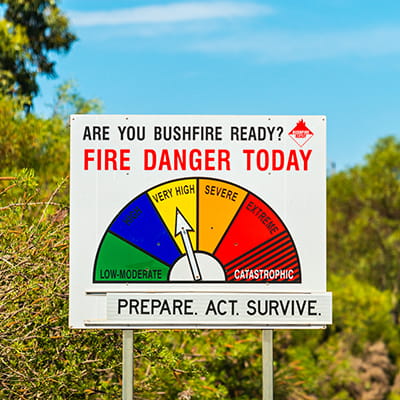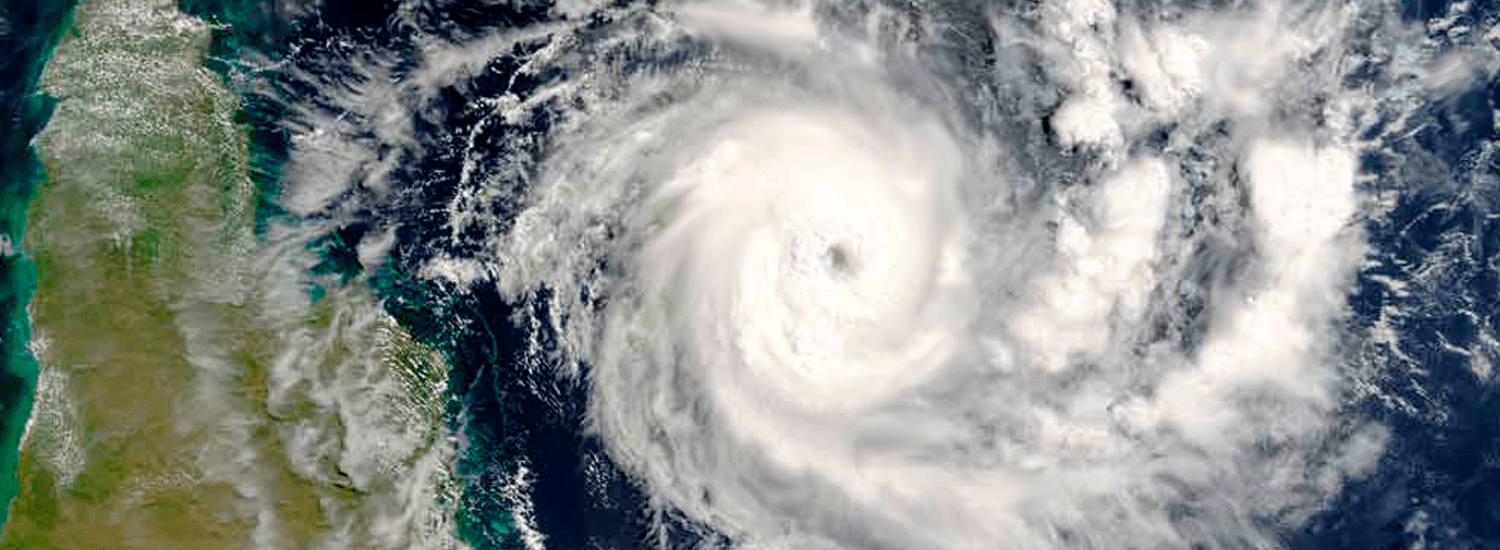Survey: Almost 85% are concerned about El Niño bushfire threat
- 84.1% of people are concerned about the impact of El Niño
- Awareness of threats posed by natural disasters is rising
- Preparation is key as we enter bushfire season
Bushfires are set to play a major role in the summer of 2023-24, after the Bureau of Meteorology (BOM) confirmed an El Niño weather event was underway.1
El Niño, together with a positive Indian Ocean Dipole (IOD), creates warmer and drier conditions, which increases the risk of bushfires.
In August 2023, QBE polled 1,000 Australians about the threats posed by natural disasters and extreme weather events, and how they were preparing themselves and their property.
Of those polled, 60% either had, or knew someone who had, their property (excluding vehicles) damaged by a weather event.2

El Niño threat is well understood
The BOM has frequently discussed the possibility of an El Niño event developing this summer, with news coverage creating wider awareness.
When surveyed, 81.3% of people said they’d heard about El Niño and how it could affect the weather.3 84.2% were concerned about the increased likelihood of bushfires.4
Of course, with the threat of bushfires comes risks to your home, property, livelihoods and – ultimately – lives.
During the bushfires of 2019-20, more than 24 million hectares of land was burned, and 483 people lost their lives.5
What’s more, 2,448 homes, 284 facilities and 5,469 outbuildings were destroyed, and a further 1,013 homes, 194 facilities and 2,042 outbuildings were damaged.
When questioned about how concerned people were about the potential danger to homes though hotter conditions through El Niño:
Australians are increasingly concerned about natural disasters and extreme weather
The conditions caused by El Niño and the positive IOD create the most prominent and imminent threat. But, in recent times, flooding and other extreme weather conditions have impacted the lives and homes of many Australians.
When questioned, 36.5% said they were more concerned about natural disasters and extreme weather events than they were 18 months ago.9
41.4% said their increased concern was through media and social media coverage, and 26.6% believed they were more educated on the topic than in early 2021.10
El Niño set to spur preventative measures – but costs are a challenge
The declaration of El Niño means many of us will be taking preventative measures and doing maintenance around the home to minimise risks.
Things like clearing gutters can make a real difference. 76.8% of respondents told us they were somewhat likely, very likely, or had already taken measures.11
Worryingly, 18.1% of respondents said their home wasn’t prepared for a natural disaster and 58.6% said their home was somewhat prepared.
Just 28% of people polled plan to add new disaster protection measures to their homes,12 and for 81.8% of those, costs were delaying putting these measures in place.13
Meanwhile, 39.8% of respondents reported being part of a local group on social media,14 and of those, 80.3% had implemented advice and tips from their community to protect their home.15
Majority of Australians surveyed don’t have a natural disaster plan
Being prepared can make all the difference, but 51.1% of people don’t know their home’s bushfire attack level (BAL), and a further 13.5% don’t know what a BAL is.16
Just 6.4% of respondents had a bushfire evacuation plan in place,17 and of those, only 8.1% had updated it in the last year.18
And of those without a plan, 34.2% believed they didn’t need one, while 17.3% didn’t know what to put in it.19
Download a bushfire plan from your local Rural Fire Service
- New South Wales
- Queensland
- Victoria
- South Australia
- Western Australia
- Northern Territory
- Australian Capital Territory
- Tasmania
Family support would be crucial for most in a natural disaster
We all hope we’re not going to get caught up in a natural disaster or extreme weather event, but we can’t rule out that possibility.
When surveyed, 84.3% of people believed they’d need accommodation in the event of bushfire, and clothing and food also ranked highly.20
If a home was uninhabitable, 68.9% said they’d rely on family for accommodation, while 37.9% would rely on their insurance company, 11.6% on neighbours and 5.8% on their employer.21
Photos and phones top of the ‘rescue’ list
If you needed to get out of your home in a hurry, what would you grab first on your way out?
When surveyed, 28.4% of people said they’d reach for their phone and 17.1% would take photos and albums. Meanwhile, 10.2% would reach for their wallets and 8.3% for their laptop.22
Insurance’s role in recovery
If your property was destroyed by a disaster, insurance can play a key role in helping you get back on your feet.
Of those who owned a home, 92.8% had home building insurance.23 40% were very confident their total buildings sum insured would cover the cost to rebuild, while 53.9% were somewhat confident, but not certain it would be enough.24
In terms of contents, 55.4% of respondents were somewhat confident, but not certain it would be enough while 36.9% were very confident that their total contents sum insured would cover the costs of replacing all of their belongings.25
6 ways to prepare your home for bushfire
1. Clear gutters, chimneys, and surrounding areas for any natural debris
Clear outdoor spaces mean there’s less fuel for a fire.
2. Look for anything flammable too
Gas bottles and outdoor furniture are easy to overlook.
3. Cut back low-hanging trees within 10m of your home
Reduce the amount of natural flammable materials.
4. Keep grass cut short
Long, dry grass is a fire risk.
5. Review your insurance
Check your policies are up to date and give you the cover you need at today’s rebuild and replacement values.
6. Have your bushfire plan handy
Take the time to create a plan. It could save your life.
For more tips about preparing for a bushfire, read our bushfire season checklist article.
Make sure your home and belongings are adequately covered. Learn about QBE Home Insurance and get a quote today.
1 https://media.bom.gov.au/releases/1183/the-bureau-declares-el-Niño-and-positive-indian-ocean-dipole-events/
2 QBE polling data August 2023
3 QBE polling data August 2023
4 QBE polling data August 2023
5 https://www.csiro.au/en/news/all/articles/2021/november/bushfires-linked-climate-change
6 QBE polling data August 2023
7 QBE polling data August 2023
8 QBE polling data August 2023
9 QBE polling data August 2023
10 QBE polling data August 2023
11 QBE polling data August 2023
12 QBE polling data August 2023
13 QBE polling data August 2023
14 QBE polling data August 2023
15 QBE polling data August 2023
16 QBE polling data August 2023
17 QBE polling data August 2023
18 QBE polling data August 2023
19 QBE polling data August 2023
20 QBE polling data August 2023
21 QBE polling data August 2023
22 QBE polling data August 2023
23 QBE polling data August 2023
24 QBE polling data August 2023
25 QBE polling data August 2023










